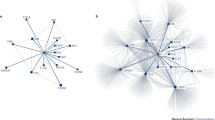Abstract
Primitive innate defense mechanisms in the form of gene-encoded antimicrobial peptides are now considered as potential candidates for the development of new therapeutics. They are well known for their function as the first protective barrier of all organisms against microbial infections. In addition, emerging studies reveal that they assist in modulating the host immune system. The biological properties of these host-defense peptides, their role in human health, their cell selectivity and related molecular mechanisms are discussed in this multi-author review along with the strategies to transform them or their peptidomimetics into clinically usable drugs.
Similar content being viewed by others
References
Boman HG (1991) Antibacterial peptides: key components needed in immunity. Cell 65:205–207
Ganz T (2003) Defensins: antimicrobial peptides of innate immunity. Nat Rev Immunol 3:710–720
Steiner H, Hultmark D, Engstrom A, Bennich H, Boman HG (1981) Sequence and specificity of two antibacterial proteins involved in insect immunity. Nature 292:246–248
Ganz T, Selsted ME, Szklarek D, Harwig SS, Daher K, Bainton DF, Lehrer RI (1985) Defensins. Natural peptide antibiotics of human neutrophils. J Clin Invest 76:1427–1435
Zasloff M (1987) Magainins, a class of antimicrobial peptides from Xenopus skin: isolation, characterization of two active forms, and partial cDNA sequence of a precursor. Proc Natl Acad Sci USA 84:5449–5453
Zasloff M (2002) Antimicrobial peptides of multicellular organisms. Nature 415:389–395
Rosenfeld Y, Papo N, Shai Y (2006) Endotoxin (lipopolysaccharide) neutralization by innate immunity host-defense peptides. Peptide properties and plausible modes of action. J Biol Chem 281:1636–1643
Hancock RE (2001) Cationic peptides: effectors in innate immunity and novel antimicrobials. Lancet Infect Dis 1:156–164
Acknowledgments
I would like to thank all authors and reviewers who contributed to this multi-author review on the biology and therapeutic strategies of HDPs. I am very grateful to Prof. Klaus Eichmann for giving me the opportunity to organize and edit such fascinating project.
Author information
Authors and Affiliations
Corresponding author
Rights and permissions
About this article
Cite this article
Mangoni, M.L. Host-defense peptides: from biology to therapeutic strategies. Cell. Mol. Life Sci. 68, 2157–2159 (2011). https://doi.org/10.1007/s00018-011-0709-3
Received:
Revised:
Accepted:
Published:
Issue Date:
DOI: https://doi.org/10.1007/s00018-011-0709-3




